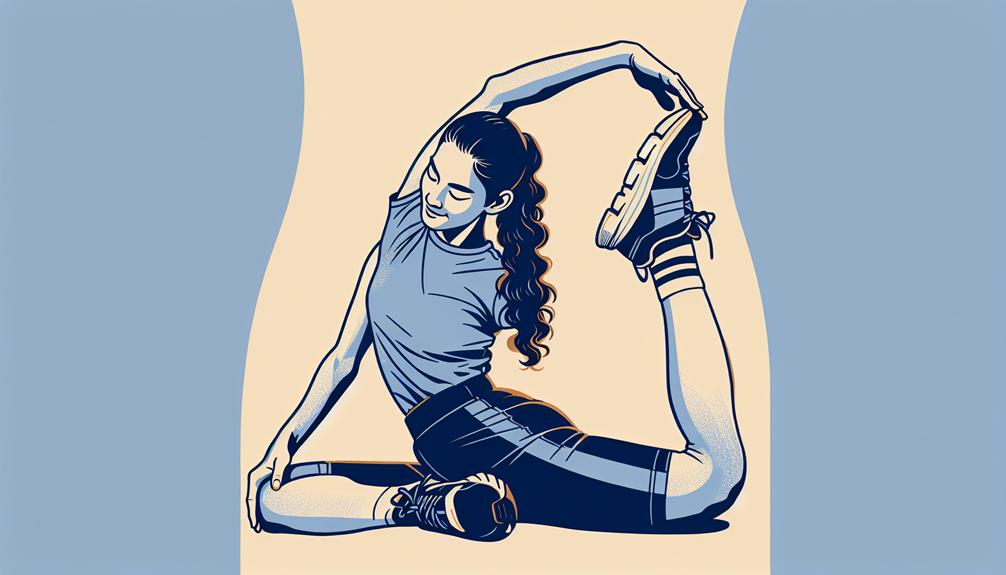Before plunging into your next workout session, let's address a common concern among fitness enthusiasts: avoiding muscle tears. Imagine a scenario where you could push your limits without fearing an injury setback. By implementing a few key strategies, you can significantly reduce the risk of muscle tears during your workouts. Stay tuned to discover practical tips that will help you achieve injury-free exercise sessions and maximize your fitness gains.
Key Takeaways
- Dynamic stretching before workouts prepares muscles and reduces the risk of tears.
- Focus on proper technique to prevent injuries and maximize workout benefits.
- Gradually increase intensity to challenge muscles safely and avoid tears.
- Incorporate stretching routines for flexibility, preventing muscle tears during workouts.
Importance of Warm-Up
Wondering why warm-ups are crucial before your workout? Dynamic stretching plays a key role in injury prevention by increasing blood flow to your muscles, improving flexibility, and preparing your body for the physical demands of exercise. When you engage in dynamic stretching as part of your warm-up routine, you are signaling to your body that it's time to move, helping to prevent muscle tears and strains.
Proper Form and Technique
To prevent muscle tears and maximize the benefits of your workouts, mastering proper form and technique is essential. Proper alignment plays a crucial role in preventing injuries. Ensure that your body is in the correct position for each exercise to avoid unnecessary strain on your muscles. Focus on maintaining a straight back, stable core, and aligned joints to distribute the workload effectively.
Breathing techniques are also key to supporting your muscles during exercise. Remember to inhale deeply before starting a movement and exhale during the exertion phase. Proper breathing helps oxygenate your muscles and improves their performance, reducing the risk of tears.
Gradual Progression in Intensity

To prevent muscle tears and enhance your workout experience, gradually increasing the intensity of your exercises is crucial. Making smart modifications and focusing on steady growth will help you build strength effectively while reducing the risk of injuries. By pushing yourself too hard, too fast, you may strain your muscles, leading to tears and setbacks in your fitness journey.
Tips for Gradual Progression in Intensity:
| Smart Modifications | Benefits | Implementation |
|---|---|---|
| Adjusting weights | Prevents overexertion | Increase weights by small increments to challenge muscles without straining them. |
| Adding reps | Builds endurance | Gradually increase the number of repetitions to improve muscular stamina. |
| Extending workout time | Enhances cardiovascular fitness | Gradually lengthen workout duration to improve overall endurance. |
Adequate Rest and Recovery
To maximize the benefits of your workouts and reduce the risk of muscle tears, ensuring adequate rest and recovery is essential. Your body needs time to repair and rebuild after intense physical activity. Here are some practical restoration strategies and recovery techniques to help you prevent muscle tears:
- Quality Sleep: Aim for 7-9 hours of uninterrupted sleep each night. During sleep, your body releases growth hormones that aid in muscle recovery and repair.
- Active Recovery: Incorporate light activities like walking, yoga, or swimming on rest days. Active recovery helps increase blood flow to your muscles, promoting faster healing.
- Hydration and Nutrition: Stay hydrated and fuel your body with a balanced diet rich in protein, healthy fats, and carbohydrates. Proper nutrition supports muscle recovery and overall performance.
Incorporating Stretching Routine

Incorporate a regular stretching routine into your workout to improve flexibility and reduce the risk of muscle tears. Dynamic stretches, like leg swings and arm circles, are great to include at the beginning of your workout. These movements help warm up your muscles by mimicking the actions you'll perform during exercise. They can enhance your range of motion and prepare your body for more intense movements.
After your workout, static stretches can be beneficial for cooling down. Hold each stretch for about 15-30 seconds, focusing on major muscle groups like hamstrings, quadriceps, and calves. This helps maintain or improve flexibility, which is essential for preventing muscle tightness and tears.
Remember that stretching should never be painful. It's normal to feel tension, but sharp or unbearable pain could indicate an underlying issue. Listen to your body and adjust the intensity of your stretches accordingly. By incorporating dynamic and static stretches into your routine, you can help keep your muscles healthy and resilient.
Frequently Asked Questions
How Can I Tell the Difference Between Muscle Soreness and a Muscle Tear?
Feeling sore after a workout is common, but if pain is sharp, persistent, or accompanied by swelling, it could be a muscle tear. Rest, ice, compression, and elevation can help. Seek medical advice for proper treatment.
Are There Any Specific Supplements or Foods That Can Help Prevent Muscle Tears?
To prevent muscle tears, focus on a balanced nutrition plan. Include dietary supplements like protein and omega-3s for muscle recovery. Hydrate well and incorporate anti-inflammatory foods. Prioritize injury prevention with proper warm-ups and cool-downs.
Can Stretching Before a Workout Actually Increase the Risk of Muscle Tears?
When stretching before a workout, proper techniques are key to preventing muscle tears. Ensure your warmups are dynamic and tailored to the specific exercises you'll be doing. Listen to your body and avoid overstretching to reduce injury risks.
Is It Possible to Overdo Rest and Recovery, and if So, How Can I Find the Right Balance?
You might think more rest is better, but overdoing it can hinder progress. Find balance by incorporating active recovery, staying properly hydrated, getting quality sleep. This not only aids injury prevention but also enhances performance.
Are There Any Warning Signs or Red Flags to Look Out for That May Indicate a Potential Muscle Tear During a Workout?
You can identify potential muscle tears during workouts by watching for warning signs like sudden sharp pain, swelling, or loss of strength. Stay safe by listening to your body, warming up properly, and not pushing through severe discomfort.
Conclusion
Remember, preventing muscle tears is crucial for injury-free workouts. By incorporating proper warm-up, form, and progression, you can reduce your risk of injury. Rest and recovery are just as important as your workout routine. Did you know that studies have shown that adequate rest can decrease your chances of muscle tears by up to 50%? So take care of your body, listen to its signals, and enjoy your workouts injury-free. Stay safe and keep pushing towards your fitness goals!













